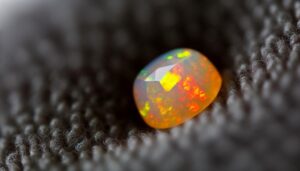10 Essential Steps to Safely Clean Your Fire Opal
To clean a fire opal, use non-abrasive materials and a gentle approach. First, inspect the opal for any cracks or crazing using a magnifying glass.
Create a solution with mild detergent and distilled water. Gently scrub the opal with a soft-bristled brush, then rinse with lukewarm water.
Pat dry using a lint-free cloth and let it air dry in a dust-free area, away from direct sunlight. Store your opal in a padded container in a stable environment with moderate humidity.
Handle it with care to avoid sudden temperature changes. There's more to maintaining this vibrant gemstone's brilliance.
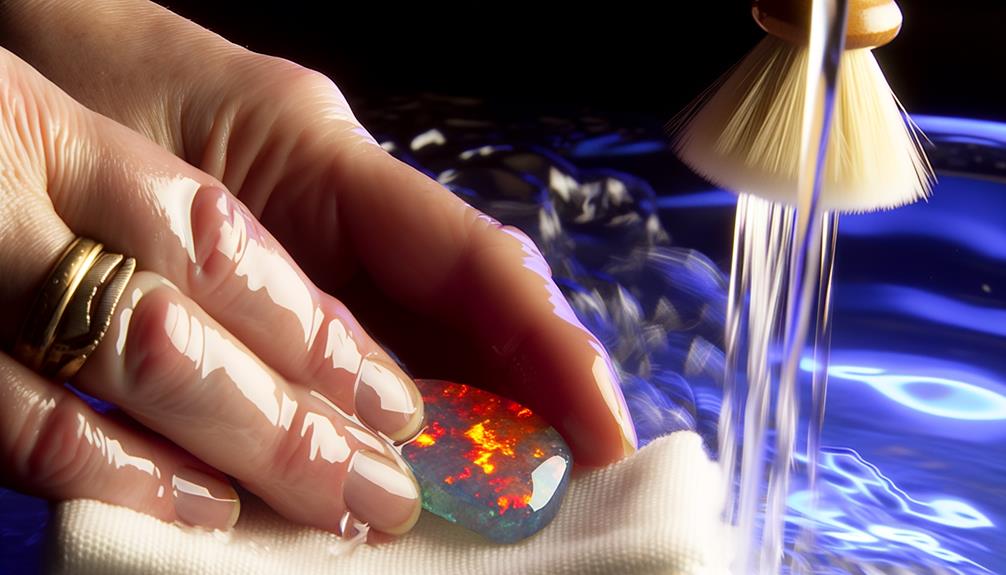
Key Takeaways
- Use a soft, lint-free or microfiber cloth to gently clean the fire opal.
- Prepare a gentle cleaning solution with mild detergent and distilled water.
- Employ a soft-bristled toothbrush to delicately clean intricate settings.
- Rinse the fire opal with lukewarm water and pat dry with a lint-free cloth.
- Store the opal in a padded container with stable temperature and humidity.
Understanding Fire Opals
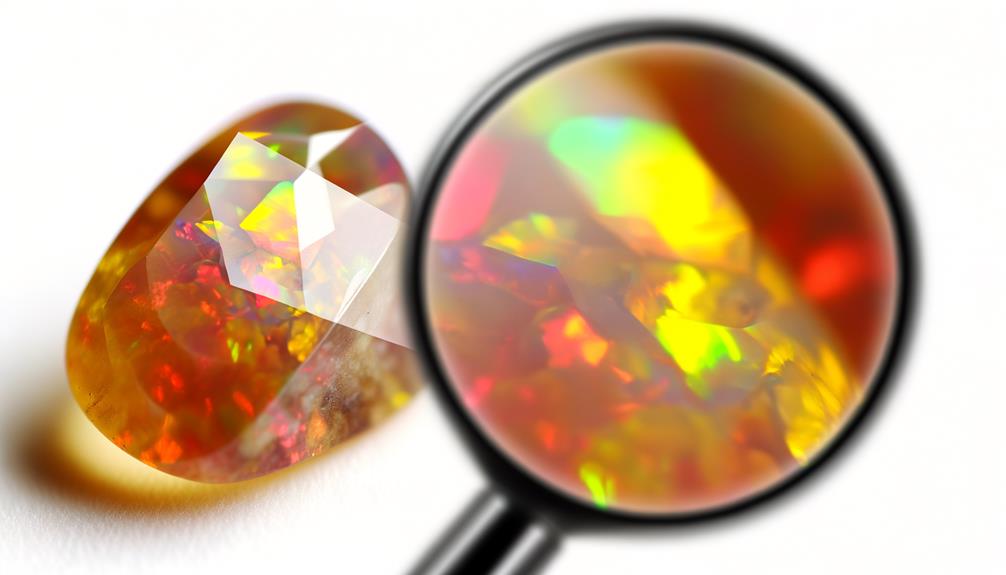
Fire opals are known for their vivid colors and unique play-of-color. They are a type of hydrated silica mineral that requires careful handling. They contain water molecules within their silica structure, making them particularly sensitive to changes in humidity and temperature. Fire opals can exhibit a range of colors, from yellow and orange to red, due to the diffraction of light through their microscopic silica spheres. This phenomenon, called play-of-color, is what makes fire opals truly unique.
However, their water content can cause them to crack or craze if exposed to extreme conditions. To maintain their brilliance, it's essential to understand these characteristics. Knowing this helps you appreciate the necessity for meticulous care in handling and cleaning fire opals.
Assessing Opal Condition
To guarantee your fire opal remains in peak condition, start by carefully examining its surface for any signs of crazing, cracks, or discoloration. Utilize a magnifying glass to inspect the opal's surface meticulously. Pay attention to the following indicators:
| Indicator | Description |
|---|---|
| Crazing | Network of fine cracks on the surface |
| Cracks | Visible fractures that may compromise integrity |
| Discoloration | Changes in color, indicating possible damage |
| Cloudiness | Loss of transparency, suggesting moisture ingress |
| Fragmentation | Small pieces breaking away from the main stone |
Each of these signs can inform you about the opal's current condition. Identifying these issues early allows you to take appropriate actions to preserve the gem's natural beauty and structural integrity.
Choosing Cleaning Materials
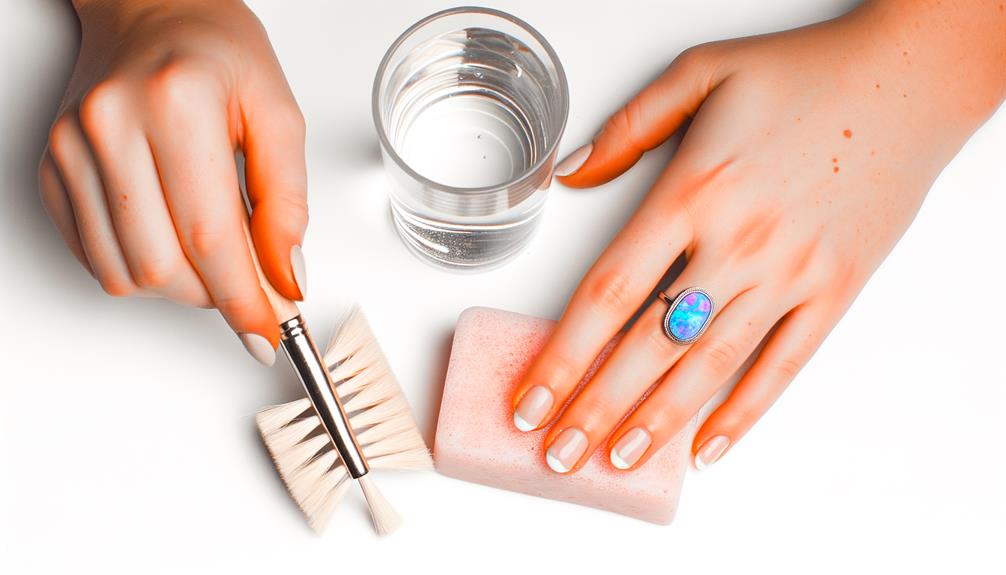
When selecting cleaning materials for your fire opal, prioritize those that are non-abrasive and specifically designed for delicate gemstones. Use a soft, lint-free cloth, as it will minimize the risk of scratching the opal's surface. Microfiber cloths are ideal due to their gentle texture and ability to trap dust and debris effectively.
Avoid using paper towels or tissues, as their fibrous nature can lead to micro-scratches.
Additionally, select a soft-bristled brush, such as a baby toothbrush, to access and clean intricate settings without causing damage. Refrain from using any cleaning agents containing harsh chemicals or abrasives. These substances can compromise the opal's structural integrity and diminish its natural luster.
Always prioritize gentle, gemstone-specific materials.
Preparing a Cleaning Solution
To prepare an efficient cleaning solution for fire opal, you need to select suitable cleaning agents that won't harm the stone. Choose a gentle detergent mixed with distilled water to avoid introducing impurities.
Make sure you maintain a proper ratio, typically one part detergent to ten parts water, for best cleaning effectiveness.
Choosing Cleaning Agents
Selecting the proper cleaning agents for fire opal involves understanding the stone's chemical and physical properties to prevent damage. Fire opal, being a hydrated amorphous silica, is sensitive to harsh chemicals and extreme temperature changes. You should avoid using abrasive or acidic substances that can scratch or corrode the stone. Instead, choose mild, non-abrasive agents such as distilled water, mild soap, and a soft brush. Here's a comparison table to guide your selection:
| Cleaning Agent | Properties | Suitability for Fire Opal |
|---|---|---|
| Distilled Water | Pure, non-reactive | Highly suitable |
| Mild Soap (pH 7) | Gentle, neutral pH | Suitable |
| Abrasive Cleaners | Harsh, can scratch surfaces | Not suitable |
Always prioritize gentle, non-reactive agents to preserve the integrity of your fire opal.
Mixing Proper Ratios
Preparing a cleaning solution for fire opal involves carefully mixing distilled water and mild soap in precise proportions to guarantee the stone's safety and cleanliness. Begin by measuring one liter of distilled water, making sure it's free from impurities that could harm the opal.
Next, add approximately 5 milliliters of mild, pH-balanced soap. It's important to use a soap that lacks harsh chemicals or abrasives. Stir the mixture gently until the soap fully dissolves, creating a uniform solution. This low-concentration mixture minimizes the risk of damaging the opal's delicate surface.
Always test the solution on a small, inconspicuous area of the opal first to confirm compatibility. Proper proportions ensure effective cleaning without compromising the stone's integrity.
Gentle Brushing Techniques
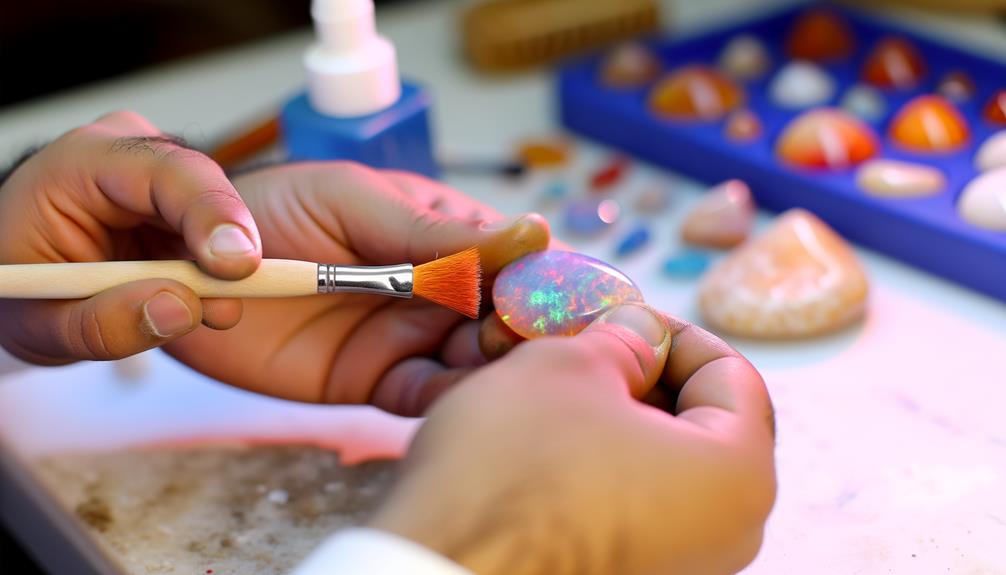
Utilize a soft-bristled toothbrush to gently clean fire opal, making sure you avoid abrasive motions that could damage the delicate surface.
Fire opal's composition includes hydrated silica, making it susceptible to scratches and abrasions. When brushing, employ a gentle circular motion to dislodge dirt and debris without applying excessive pressure. This technique minimizes the risk of microfractures or loss of luster.
It's important to use lukewarm water during this process, as extreme temperatures can cause thermal shock, potentially leading to cracks. Check that the toothbrush bristles are free of any contaminants that could introduce unwanted particles onto the opal's surface.
Using Soft Cloths
After gently brushing the fire opal, you should use a soft, lint-free cloth to carefully dry and polish the surface, ensuring no moisture remains that could affect the stone's integrity.
This step is pivotal because fire opals are hydrophane, meaning they can absorb water, which may lead to discoloration or structural weakness.
Gently press the cloth against the opal, using light circular motions to avoid applying excessive pressure that might cause microfractures. A microfiber cloth is highly recommended due to its non-abrasive texture, which minimizes the risk of scratching.
Regularly inspect the cloth for debris that could scratch the opal. By meticulously drying and polishing, you help maintain the opal's vibrant play of color and structural integrity.
Avoiding Harsh Chemicals
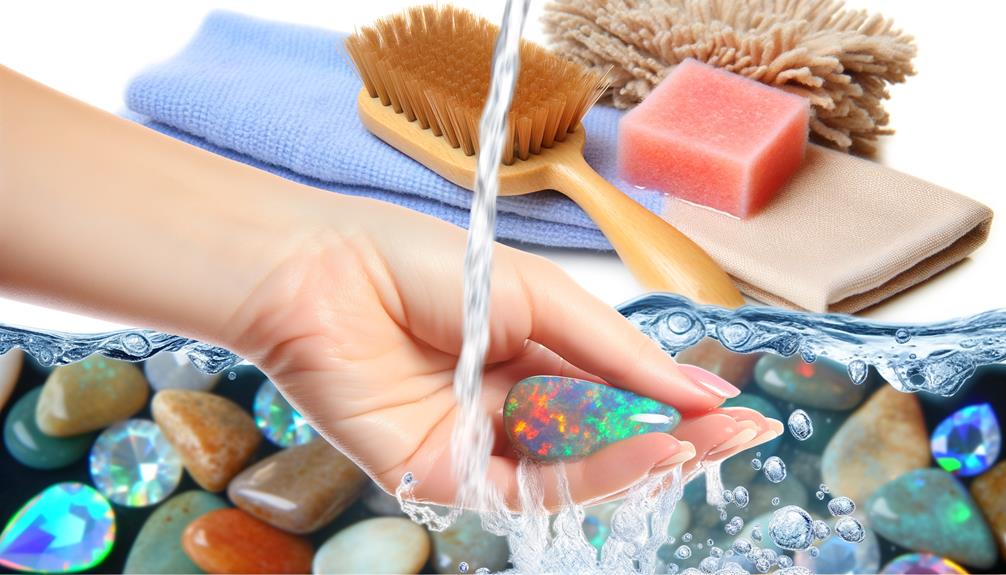
Avoiding harsh chemicals is crucial when caring for fire opals. These gemstones are highly sensitive and can be easily damaged by substances like bleach or ammonia. Such chemicals can cause discoloration, surface etching, or even structural weakening of the fire opal. Instead, opt for mild detergents with neutral pH levels to maintain the integrity of the gemstone. It's essential to ensure the cleaning solution is well-diluted to minimize any risk of damage. When selecting a cleaning agent, always check the label to confirm it's free from abrasives and strong solvents.
Additionally, it's advisable to avoid using ultrasonic cleaners on fire opals. The vibrations produced by these cleaners can create micro-fractures in the opal, leading to potential damage. By carefully choosing your cleaning materials and methods, you can preserve the brilliance and longevity of your fire opal. This attention to detail will help ensure that your fire opal remains a cherished piece for years to come.
Rinsing Properly
When rinsing your fire opal, don't use hot or cold water; opt for lukewarm water to prevent thermal shock.
Handle the opal gently to avoid microfractures or surface damage.
Guarantee you rinse thoroughly to remove all cleaning residues without applying excessive force.
Use Lukewarm Water
Rinse the fire opal with tepid water to prevent thermal shock and preserve its structural integrity. Tepid water, usually around 90-110°F (32-43°C), minimizes the risk of sudden temperature changes that can fracture the opal. Maintain a steady flow of water to remove any debris or residue gently.
Here's a quick reference table:
| Water Temperature | Effect on Fire Opal | Recommended Action |
|---|---|---|
| Cold (<60°F) | Potential cracking | Avoid use |
| Tepid (90-110°F) | Safe and effective | Preferred for rinsing |
| Hot (>120°F) | Thermal stress risk | Avoid use |
Consistent rinsing guarantees the opal remains free from residues without compromising its delicate structure. Always prioritize gentle, even water flow to maintain the gem's natural beauty.
Gentle Handling Techniques
How can you make sure that your fire opal remains undamaged during the rinsing process?
First, verify you're using only lukewarm water, avoiding extreme temperatures that could cause thermal shock. Hold the fire opal gently between your thumb and forefinger, applying minimal pressure to prevent stress fractures. Direct a gentle stream of water over the stone, ensuring it flows uniformly, avoiding abrupt force that might chip the delicate surface.
Rotate the opal slowly, confirming all residues are washed away. Avoid using any abrasive materials, as fire opals are particularly susceptible to scratching due to their relatively low hardness on the Mohs scale.
Pat the opal dry with a soft, lint-free cloth, avoiding vigorous rubbing that could damage the stone's integrity.
Drying Methods
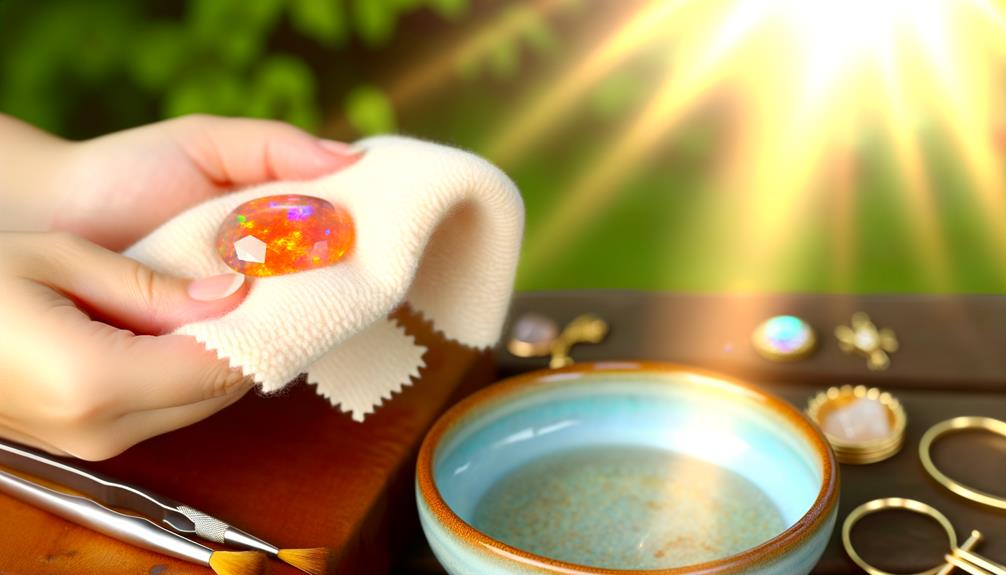
After cleaning, make certain your fire opal is dried thoroughly to prevent any damage or water spots. Use a soft, lint-free cloth to gently pat the opal dry. Avoid using paper towels as they can scratch the surface.
Next, let the opal air dry completely in a dust-free environment. Guarantee no direct sunlight or heat sources are near, as excessive heat can cause the opal to crack. For a more controlled drying process, you can use a fan set to a low speed, ensuring the airflow isn't too forceful.
If moisture remains, it could lead to mineral deposits forming, which may affect the opal's brilliance. Always prioritize a gentle, gradual approach to preserve the stone's integrity.
Storing Fire Opals
Proper storage of fire opals is essential to maintaining their brilliance and preventing damage. Store your fire opals in a dark, temperature-stable environment to avoid thermal shock, which can cause cracking.
Use a padded container to cushion them and prevent scratches. Fire opals are hydrophane, meaning they can absorb water and change appearance; maintain humidity levels around 55-75%. Place a damp cloth nearby to retain moisture without direct contact.
Avoid storing fire opals with harder gemstones that might cause abrasions. Always separate them individually within soft pouches or compartments to minimize friction. By following these guidelines, you'll make sure the longevity and aesthetic appeal of your fire opals remain uncompromised.
Regular Maintenance Tips

You should employ gentle cleaning techniques to avoid scratching or damaging your fire opal's delicate surface.
Store the opal in a soft, padded container to prevent accidental impacts and moisture exposure.
Regularly inspect the stone for any signs of damage, such as cracks or discoloration, to maintain its pristine condition.
Gentle Cleaning Techniques
To preserve the brilliance of your fire opal, utilize a soft, lint-free cloth for regular dusting to prevent surface scratches. Use lukewarm, distilled water for gentle cleaning, as hard water can leave minerals on the opal. Avoid harsh chemicals or ultrasonic cleaners, which can harm the opal's delicate structure. Employ these gentle techniques for sustained clarity and shine:
- Utilize a soft brush: Choose a baby toothbrush to access intricate settings without causing abrasions.
- Gentle soap solution: Combine a drop of mild dish soap with distilled water for a mild yet efficient cleaning solution.
- Thoroughly rinse: Make sure no soap residue remains, as it can diminish the opal's luster.
- Blot dry: Use a microfiber cloth to prevent scratching and guarantee complete dryness.
Safe Storage Practices
Storing your fire opal in a cushioned, fabric-lined jewelry box prevents abrasions and minimizes exposure to harmful elements. Fire opals are hydrophane, meaning they can absorb water and other liquids, potentially causing structural changes or color loss.
Maintain your storage environment with stable humidity levels, ideally between 45-60%, to prevent dehydration or excess moisture absorption. Avoid extreme temperature fluctuations, as they can induce cracks or crazing.
Position your jewelry box away from direct sunlight and heat sources to mitigate thermal stress. Additionally, isolate your fire opal from harder gemstones to prevent scratches.
Regularly inspect the storage conditions, making sure the fabric lining remains clean and free from debris. Proper storage preserves your fire opal's brilliance and structural integrity.
Inspecting for Damage
Regularly examine your fire opal for any signs of damage, such as surface scratches, fractures, or loss of luster. Regular checks guarantee early detection of issues that could compromise the stone's integrity. Use a jeweler's loupe to scrutinize the opal's surface meticulously.
Look for:
- Surface scratches: These can diminish the opal's brilliance and should be addressed promptly.
- Fractures: Cracks or breaks weaken the structural stability of the stone.
- Loss of luster: This indicates the opal's polish might be wearing off, reducing its visual appeal.
- Discoloration: Changes in color can indicate exposure to harsh chemicals or extreme temperatures.
Handling With Care
When handling fire opal, make certain you use soft, non-abrasive materials to prevent scratching its delicate surface. Natural fire opal is composed of hydrated silica, making it more vulnerable to damage from physical and thermal stress.
Always use a microfiber cloth or a soft cotton pad when touching or cleaning the gemstone. Avoid sudden temperature changes, as the thermal expansion can cause fractures in the opal.
Handle the fire opal with clean, dry hands to minimize the risk of transferring oils or contaminants. When setting or storing, make sure the gem is cushioned and isolated from harder gemstones to prevent accidental abrasion.
Proper handling preserves the opal's vibrant play-of-color and extends its longevity.
Professional Cleaning Options

If you're unsure about cleaning your fire opal at home, professional jewelers offer specialized services designed to preserve the stone's integrity and brilliance. These experts use techniques that minimize any risk of damage while safeguarding the vibrancy of your opal.
- Ultrasonic Cleaning: Jewelers employ ultrasonic devices that use high-frequency vibrations to gently eliminate debris.
- Steam Cleaning: Professionals use steam to cleanse the opal, avoiding harsh chemicals that could potentially harm the delicate stone.
- Inspection: Jewelers examine the opal for any structural issues before and after cleaning, providing peace of mind.
- Polishing: Experts can polish the opal to restore its original shine without compromising its surface.
Opting for professional cleaning safeguards the longevity and beauty of your fire opal.
Conclusion
Essentially, preserving the radiance of your fire opal involves a combination of careful attention and occasional maintenance.
By evaluating its state, selecting suitable cleaning supplies, and utilizing gentle brushing methods, you guarantee its durability.
Correct storage and routine upkeep additionally protect its beauty.
Treating it with utmost delicacy and exploring expert cleaning services when necessary will maintain the exquisite appearance of your fire opal.
Through these measures, you're not simply safeguarding a gem; you're fostering an ageless gem.

